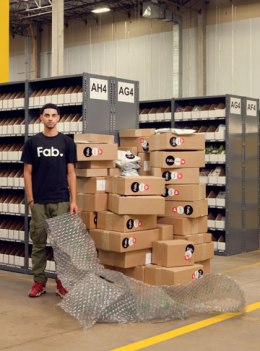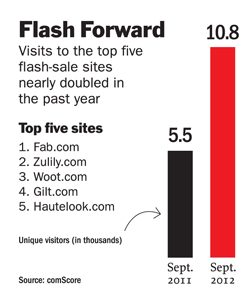
From its New Jersey warehouse, Fab sells a quirky mix of products.
The sample sale is one of those classic New York experiences: an exhilarating mix of rarefied luxury and down-and-dirty bargain hunting. Lovers of haute couture line up at some unglamorous hour for the privilege of fighting in a crowded showroom over the last size-four Alessandro Dell’Acqua leather jacket. When Gilt pioneered the online flash sale in the U.S. in 2007, it managed to re-create the backdoor chic of a sample sale without the pushing and shoving. The site lures in-the-know shoppers into private online sales of top designer clothing that are over in a flash, lasting only a day or two. Instead of sparring with aggressive shoppers, luxury lovers can claim that sacred pair of Prada heels from the comfort of their living room.
Gilt’s success has attracted dozens of imitators, and flash sales have turned into a booming $2 billion business. All these slickly produced websites, including HauteLook, Rue La La and Fab, follow the same model of enticing consumers to buy high-end merchandise through limited-time online events. The flash-sale industry has moved well beyond its high-fashion roots, selling everything from baby carriages to kitchen utensils to exotic vacations. Even Gilt, home of Hermès and Moschino, has begun selling gym passes and kitchen appliances. “There are only so many A brands in the world,” says Gilt CEO Kevin Ryan. “If we’re going to do 20 sales a day, we can’t do all A brands.” Will more-style-conscious consumers follow them to the B list?
(MORE: The New Shape of Retail)
While the industry maintains a high-gloss veneer of luxury, most flash sales are really recession businesses. Many sites make their living peddling luxury’s leftovers. In their infancy, some sites admitted shoppers only by invitation to heighten the sense of exclusivity. That appealed to high-end brands looking to off-load their overstock discreetly rather than dumping it at dowdier shops like Marshalls and T.J. Maxx. To maintain a steady stream of inventory, some flash-sale companies buy merchandise up front from wholesalers or retailers for immediate sale or squirrel it away in warehouses for the next season. Others act as brokers, taking a cut of the sales once customers place an order.
The White-Glove Treatment
Then comes the dressing up. Whether sold on consignment or from a flash-sale company’s inventory, most products listed on sites like Gilt and Rue La La pass through a warehouse where they are packaged in branded boxes filled with niceties like tissue paper, stickers and personal notes to enhance the white-glove experience. Some sites spend heavily on high-tech photography studios, models and photo editors whose job is to make each item on the site look fresh and glamorous. “We’ve invested a great deal in our photo studio,” says Rue La La CEO Ben Fischman. “It takes a lot of manpower. Most people don’t realize the importance of that in creating success in this business.”

The global financial crisis hit high-fashion brands hard, so they unloaded their excess inventory in flash sales, fueling revenue growth of about 50% annually over the past five years. As the economy has recovered and luxury labels have reduced their inventories, flash-sale websites have less couture to sell. “If you want good inventory, you have to pay for it,” says Sucharita Mulpuru, an e-retail analyst at Forrester Research. “The margins in the industry are not that favorable, and the photography and creative aspects are expensive.”
As a result, growth is likely to slow to 25% this year and to less than half that in 2013. Some players, like Ideeli and Beyond the Rack, have lost customers, while others have pared back less lucrative areas of the business by laying off staff or closing offices. Most of them have yet to turn a profit, prompting some analysts to question whether the business model is sustainable. “It was one thing for flash sales to do well during the downturn, but most luxury brands are aspiring to never be sold through these channels,” says luxury expert Jean-Marc Bellaiche of the Boston Consulting Group.
(MORE: Target Turns 50: How the Discount Chain Stays Chic)
The flash-sale businesses that have thrived have moved well beyond high fashion. Fab, for example, caters to design lovers with fanciful items like iPhone cases, artwork and wheel-thrown vases. Zulily, a site targeting mothers and kids, hopes to skirt the competition by offering kitchen tools, face creams and jewelry alongside the usual baby wares. These niche flash-sale websites rely on their editorial sensibilities to lure customers, rather than just the promise of a great deal. “There’s a personality behind Fab that’s hard to replicate,” says Fab CEO Jason Goldberg, whose quirky products share a colorful, mod look. “We’re just about discovering great stuff people can’t find elsewhere at great prices.” Fab is also selling more items that are regularly stocked to balance out its flash sales. “We were never about inventory liquidation or closeouts,” he says.
For small designers in search of more customers, flash sales on well-curated sites hold big appeal. Mary Bauer, president of Baltimore-based children’s-furniture designer Bratt Decor, has sold her wares at a discount on Gilt several times in the past year. For the limited run of a flash sale, her product gets the website’s full attention. That’s a more effective way for her to sell her souped-up cribs and changing tables than going through a conventional online retailer that spends less on marketing or a brick-and-mortar store, which will “clump us in with everybody else or hide our brand because they don’t want customers buying it elsewhere online,” she says.
No Hermès for You
Other flash-sale companies are staying competitive by getting even more exclusive. Gilt has started targeting specific customers: the biggest spenders on the site may log on to find a different set of products, by fussier labels, than those who spend, say, $1,000 a year. Ryan says this carefully targeted marketing helps lure brands “that wouldn’t have ever considered coming on our site before.” Still, there are limits to the number of high-end customers those tactics can attract. “These are mostly people buying stuff for 30¢ on the dollar, not $1 million-a-year luxury spenders,” says Mulpuru of Forrester. “Most big apparel brands already have their own email lists from big customers.”
The growth of flash sales has also attracted the notice of online retail’s unavoidable behemoth, Amazon. The company started its own flash site, MyHabit, last year and has already grabbed a significant chunk of the market. Amazon is combining its unparalleled reach with a more exclusive aesthetic to lure high-end labels like Bratt. “We never considered Amazon in the past because I thought it cheapened the brand,” says Bauer. “But Amazon is changing the way it markets and will be a better fit for us. You cannot beat them for sheer visibility. It’s the biggest stage we’ve ever been on.” It’s difficult for small flash-sale websites to compete with Amazon on price or shipping, but they are trying. Rue La La rolled out new shipping discounts this year, and Fab says similar discounts are coming.
What the best flash-sale websites have figured out is that ticking timers are just one part of the thrill of shopping at a sample sale or its online equivalent. The other part is knowing that every dress waiting in that showroom is beautifully designed and painstakingly made, even if there’s only one in your size. Re-creating that feeling online for millions of shoppers is much harder.

